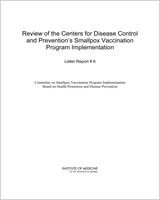NCBI Bookshelf. A service of the National Library of Medicine, National Institutes of Health.
This report may seem like a departure from the committee's previous work, which focused on smallpox vaccination as a part of public health preparedness. However, this report responds to a CDC request for guidance as the agency moves toward comprehensive preparedness for bioterrorism and other public health disasters, and toward broad smallpox preparedness efforts. The committee was asked to look specifically at preparedness exercises, which are required by CDC grant guidance and are being conducted by public health agencies. In general, the public health community has somewhat limited experience with exercises, so the committee was asked to describe the state of the science in evaluation of exercises, to identify leadership and experience to build on, and to identify issues or concerns about the use of exercises as a means to performance measurement.
Contents
- THE NATIONAL ACADEMIES
- COMMITTEE ON SMALLPOX VACCINATION PROGRAM IMPLEMENTATION
- REVIEWERS
- PREFACE
- REVIEW OF THE CENTERS FOR DISEASE CONTROL AND PREVENTION'S SMALLPOX VACCINATION PROGRAM IMPLEMENTATION. Letter Report #6
- INTRODUCTION
- INTEGRATING PUBLIC HEALTH INTO DISASTER PREPAREDNESS AND RESPONSE: CONCEPTUAL ISSUES
- CHALLENGES AND OPPORTUNITIES INHERENT IN INTEGRATING PUBLIC HEALTH INTO A BROADER FIELD
- THE EVIDENCE BASE FROM DISASTER RESEARCH AND PRACTICE
- LEARNING FROM THE PUBLIC HEALTH RESPONSE TO PROXY EVENTS
- USEFULNESS OF MODELING
- USEFULNESS OF EXERCISES
- CONCLUDING REMARKS
- References
- Appendix A SUMMARY OF RECOMMENDATIONS
- Appendix B ACRONYMS AND GLOSSARY
This study was supported by Contract No. #200-2000-00629 between the National Academy of Sciences and the Centers for Disease Control and Prevention. Any opinions, findings, conclusions, or recommendations expressed in this publication are those of the author(s) and do not necessarily reflect the view of the organizations or agencies that provided support for this project.
NOTICE: The project that is the subject of this report was approved by the Governing Board of the National Research Council, whose members are drawn from the councils of the National Academy of Sciences, the National Academy of Engineering, and the Institute of Medicine. The members of the committee responsible for the report were chosen for their special competences and with regard for appropriate balance.
